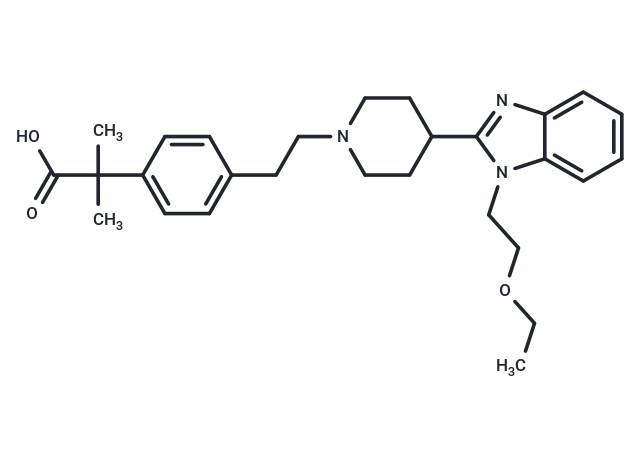Shopping Cart
Remove All Your shopping cart is currently empty
Your shopping cart is currently empty
Bilastine (Bilaxten) is a novel new-generation antihistamine that is highly selective for the H1 histamine receptor, has a rapid onset and prolonged duration of action.

| Pack Size | Price | USA Warehouse | Global Warehouse | Quantity |
|---|---|---|---|---|
| 25 mg | $39 | In Stock | In Stock | |
| 50 mg | $64 | In Stock | In Stock | |
| 100 mg | $105 | In Stock | In Stock | |
| 500 mg | $243 | In Stock | In Stock | |
| 1 mL x 10 mM (in DMSO) | $39 | In Stock | In Stock |
| Description | Bilastine (Bilaxten) is a novel new-generation antihistamine that is highly selective for the H1 histamine receptor, has a rapid onset and prolonged duration of action. |
| Targets&IC50 | H1 receptor(guinea-pig cerebellum):44.15 nM(Ki) |
| In vitro | Bilastine has a highly selective affinity for the H1-receptor but a very low affinity for 30 other tested receptors. It isn't obvious inhibitory against bradykinin, serotonin, muscarinic M3-receptors, leukotriene D4, calcium, α1-adrenoceptors, β2-adrenoceptors, and H2- and H3- receptors. |
| In vivo | In patients with allergic rhinoconjunctivitis, Bilastine is efficacious in all nasal symptoms including obstruction and in eye symptoms. In the fasting state, Bilastine is quickly absorbed, but the absorption is slowed when it is taken with food or fruit juice. |
| Synonyms | Bilaxten |
| Molecular Weight | 463.61 |
| Formula | C28H37N3O3 |
| Cas No. | 202189-78-4 |
| Smiles | CCOCCn1c(nc2ccccc12)C1CCN(CCc2ccc(cc2)C(C)(C)C(O)=O)CC1 |
| Relative Density. | 1.16g/cm3 |
| Color | White |
| Appearance | Solid |
| Storage | Powder: -20°C for 3 years | In solvent: -80°C for 1 year | Shipping with blue ice/Shipping at ambient temperature. |
| Solubility Information | DMSO: Slightly soluble |
| Size | Quantity | Unit Price | Amount | Operation |
|---|

Copyright © 2015-2025 TargetMol Chemicals Inc. All Rights Reserved.